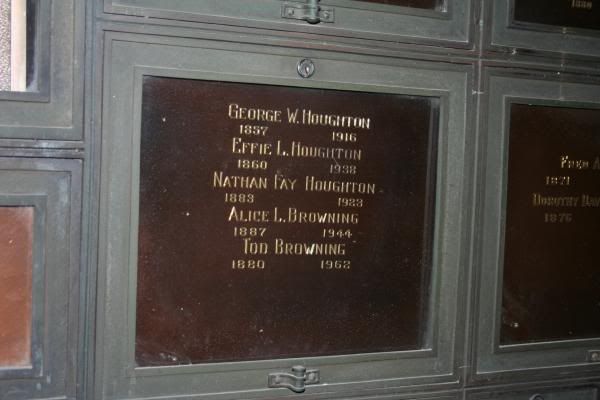
Tod Browning sírhelye az Angelus-Rosedale temetőben (Los Angeles, California)
Angelus-Rosedale Cemetery is the final resting place for classic horror film director Tod Browning. While Browning dabbled in most of the other genres as well, it is his work in the horror genre that earned him the moniker of "The Master of the Macabre" and for which he is best known today. Of the horror films he made, his adaptation of the Bram Stoker novel Dracula (1931), starring Bela Lugosi in the title role, is easily his most recognizable work. However, Browning compiled an impressive resume in the genre and worked with some of the best-known horror stars of the day; including Lugosi, Lon Chaney, Lionel Barrymore, Henry Hull, Dwight Frye, Lionel Atwill, and Edward Van Sloan.
Born as Charles A. Browning Jr. to a prominent family in Louisville, Kentucky in 1880, Browning decided to give it all up at the age of 16 and ran away to join a circus. There, he changed his name to Tod and took up a variety of jobs in the carnival life. His journey ultimately led him to New York where he met up with film director D.W. Griffith and began acting in several of Griffith's movies, ultimately moving to Los Angeles, California. Before long, he took up directing several short silent films and his career was on the rise. Following a near-fatal car accident that took the life of actor Elmer Booth, and severely injured both Browning and actor George Siegmann, Browning landed his first directing job on a feature length film with Jim Bludso (1917).
In 1919, he was teamed up with actor Lon Chaney for the silent film, The Wicked Darling (1919), which began a long collaboration between the two. Among the duo's ten films they did together was The Unholy Three (1925), which involved three circus performers who turn to a life of crime. Given the film's success, it was remade again in 1930 sans Browning and was Chaney's only talking role before succumbing to throat cancer the same year. It was also one of his first films to recall his former carnival life and a theme that would once again reappear in The Unknown (1927), with Lon Chaney and growing star, Joan Crawford. The story involves a love-triangle between an armless knife thrower (Chaney), a carnival girl (Crawford), and circus strongman (Norman Kerry) - A similar theme that would once again resurface in perhaps Browning's most controversial film, Freaks (1932). Browning and Chaney would also work the 1927 film, London After Midnight, which aside from being the first foray into the subject of vampires for Browning, is also considered one of the most sought after "lost" films after the last known print was destroyed in a MGM film vault fire in 1965.
In 1931, Browning would really hit the mark with the highly successful adaptation of Dracula; a film of which he directed, produced, and wrote (the latter of which he received no credit). Originally, the role of the count had been intended for Lon Chaney, but after his death, the producers settled on Hungarian actor, Bela Lugosi, who was already receiving rave reviews in the role on Broadway. Interestingly enough, Lugosi had already appeared in a supporting role in Browning's The Thirteenth Chair (1929). Dracula would go on to be a smash-hit and usher in the era of Universal horror movies.
Following the success of Dracula, Browning would suffer a major blow with one of his next films. Freaks (1932) was something of a pet project for Browning that recalled his days in the carnival. The story followed a love-triangle between a circus midget, a trapeze artist, and a strongman that ended with horrific results. Browning decided to cast people with actual deformities to play the role of the "freaks" in the film, rather than rely on the normal special effects and make-up. The use of people with such deformities was deemed too shocking for audiences and combined with the rather graphic mutilation scenes towards the end, the film met with instant controversy; even suffering the indignation of being banned in the United Kingdom for over 30 years. Today, the film is considered a revered cult classic, but the controversy at the time severely derailed Browning's career. He went on to make a few more films over the next couple of years (including re-teaming with Lugosi for Mark of the Vampire (1935), a remake of London After Midnight), but by 1939 his filmmaking days were over.
When his wife, Alice (who starred in films under the name Alice Wilson), passed away in 1944, Browning began to live a life of isolation. Soon after, trade newspaper Variety mistakenly printed his obituary. It is said that Browning refused to talk about his career in films with anybody and left no writings or personal reflections. In 1958, he moved into a friend's home (reportedly his veterinarian) in Brentwood where he ultimately passed away on October 6, 1962 after a battle with cancer and a recent stroke. His body was cremated and interred with the remains of his wife and her family. His marker can be found in the Mausoleum on the grounds of Angelus-Rosedale Cemetery around halfway down the east wall of the left-side corridor from the entrance.

Megjegyzések
Megjegyzés küldése